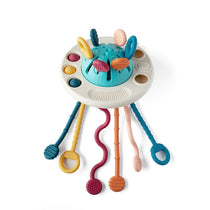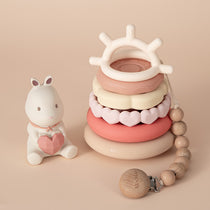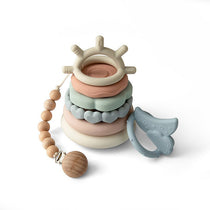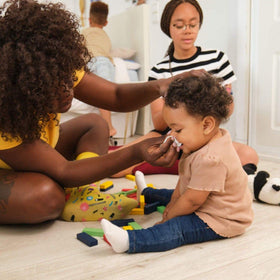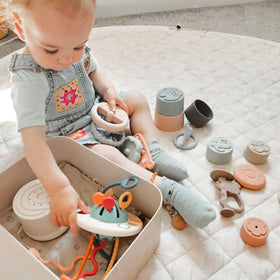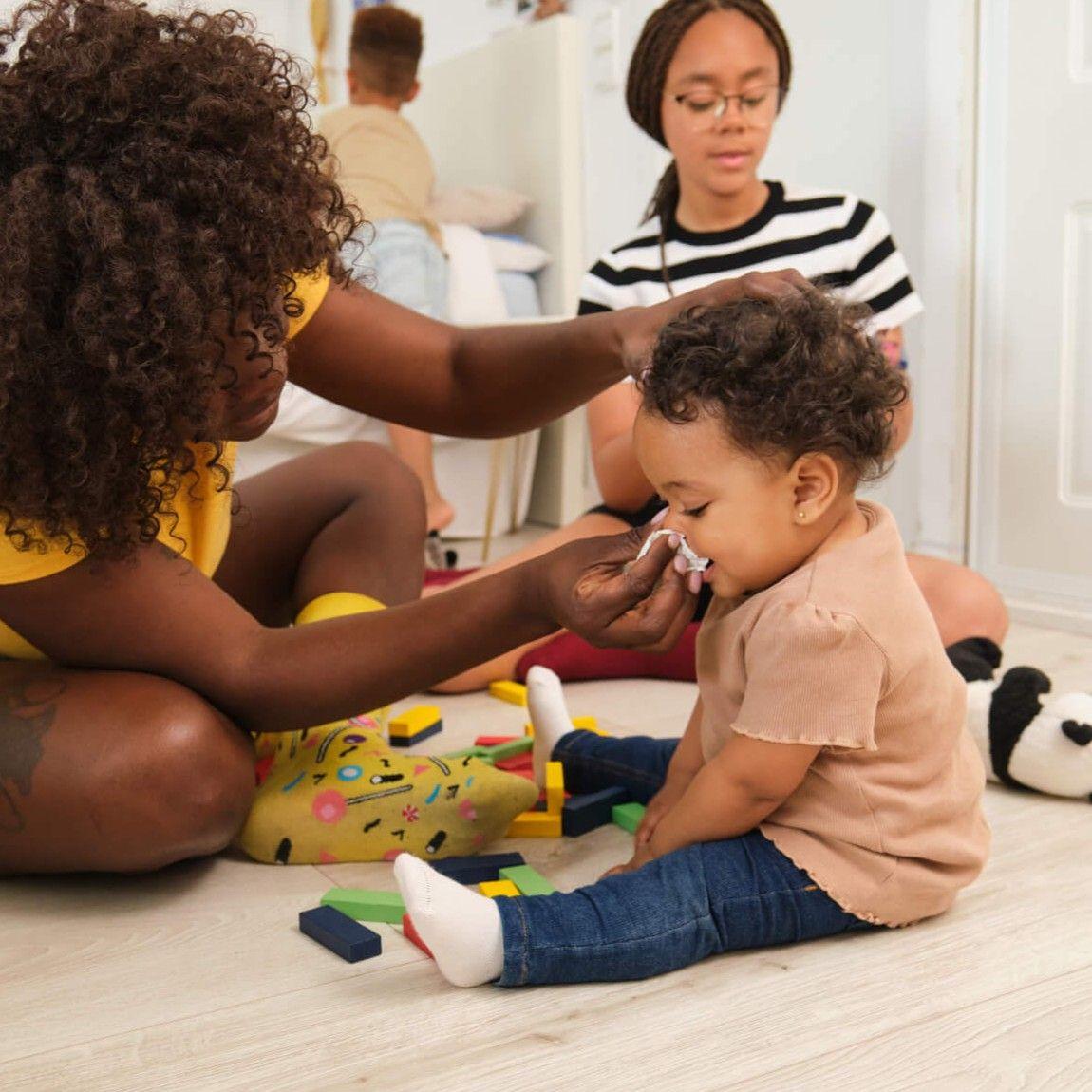Your toddler is playing peacefully on the floor for twenty minutes, minding his own business. Then you get a phone call, and suddenly, your toddler has tons of questions, starts hitting you, throws a tantrum, and gets hurt doing so. What is going on? Can't you have a five-minute phone call?
Attention-seeking behavior exists in all young children but can range from positive to negative. Children may engage in negative attention-seeking when they feel ignored, unheard, unseen, frustrated, desperate, lonely, or many other feelings when good behavior doesn't get the attention they desire.
Attention-seeking behavior is a normal part of child development, but understanding what is appropriate and what isn't, and how to encourage healthy attention-seeking, is critical to handling it in the moment. Let's dive in!
What Is Attention-Seeking Behavior?
Attention-seeking is behaving in a way (consciously or unconsciously) that attracts notice and makes oneself the focus of others' attention (source). Attention-seeking behavior spans all ages; however, this article will focus on toddlers and young children.
Seeking attention is a natural part of development, as little ones don't have the words to express their needs and emotions. Attention-seeking is one way they communicate that they need you or feel insecure, upset, unseen, embarrassed, or any number of other emotions.
Toddlers and young children need attention from their parents and caregivers, especially positive attention (source). Positive attention builds a sense of trust, security, and belonging. It reinforces "good" actions, while negative attention discourages "bad" actions.
However, a young child who is "starving" for attention may seek both positive and negative attention. For example, if finishing a coloring page doesn't gain much attention, then coloring the wall might.
Some attention-seeking behavior is normal, and some can signal a deeper problem. Understanding the difference between healthy and unhealthy attention-seeking actions can help you provide what your little one needs.
The Psychology Behind Attention-Seeking
Your toddler's physical and cognitive development is unfathomably rapid. For instance, from 0 to 3 years old, your toddler is creating one million new neural connections every second (source). By 5 years old, your little one's brain will be 90% of its eventual adult size.

Toddlers thrive on interaction and validation from their parents. So, when they feel unheard or unseen, they may resort to attention-seeking behaviors to draw you in.
Emotional needs are often the core of attention-seeking behaviors. Anxiety, loneliness, or overwhelm from environmental changes — such as a new sibling or starting preschool — may increase or escalate attention-seeking behavior.
In these cases, toddlers are seeking connection, security, or affirmation, so an empathetic response will go further to addressing underlying problems than frustration.
However, not all attention-seeking behavior signals an underlying emotional need: some toddlers have a dramatic personality. Dramatic toddlers will need help understanding appropriate boundaries in certain settings.
What Does Attention-Seeking Behavior Look Like?
Toddler attention-seeking behavior can vary significantly, but common signs are frequent interruptions, loud outbursts, or disruptive behaviors during quiet moments. It cannot be one-off instances— attention-seeking behavior typically shows up repeatedly.
Attention-seeking behavior can look like any of these:
Asking you lots of questions when you are on the phone
Asking for help to get dressed despite being able to dress herself
Lying or exaggerating to get more attention for a story he is telling
Throwing a tantrum in public
Ignoring instructions
Breaking well-established rules
Hitting or pushing
Big emotional displays when not genuinely upset
Destroying things to get a reaction
It's essential to distinguish between typical toddler behavior (such as curiosity and exploration) and more pronounced attention-seeking behavior. Healthy behaviors are asking to help, offering something they colored or made, asking questions, or showing off a new skill.
Unhealthy attention-seeking behaviors might be aggressive or incredibly disruptive. Recognizing patterns and triggers can help you effectively respond to your toddler's emotional needs.
What Are Common Triggers for Attention-Seeking Behavior?
Big changes in a little one's environment, such as moving, starting daycare, or welcoming a new sibling, can make him feel less secure, sparking attention-seeking behavior.
More common disruptions to routines can also trigger attention-seeking behaviors, such as doctors' appointments, a parent's work trip, vacation, or days of rain or snow. External stressors like family conflicts, a parent's perpetual dissatisfaction with life, or even maternal leave can also invoke attention-seeking.
Anything that causes toddlers to grapple with their feelings of unmet expectations, missing someone, feeling left out, anger, fear, or sadness can be a trigger.
Another trigger could be what your little one sees or hears. Read more about observational learning in Be Careful Mommy Daddy What You Say: Building Your Child's Identity.
5 Tips for Handling Your Toddler's Attention-Seeking Behavior
The first thing most of us want to do when our kids choose the worst possible time to be "needy" is yell or swiftly discipline them by spanking, sending them to their room, or taking something away. However, toddlers seeking attention are often expressing a need in the only way they know how to express it.

It will be several years before your toddler understands what to call each emotion and even more years before he can figure out how to address emotional needs. Thankfully, there are some ways you can help your child navigate his feelings and reduce attention-seeking behavior.
1. Positive Reinforcement
Positive reinforcement involves praising your child when she engages in healthy behaviors, such as sharing, playing nicely, offering a compliment to someone, focusing on a task instead of giving up, and many other positive actions.
Highlighting your child's positive actions with positive attention encourages your child to seek attention in constructive ways. If you usually only make eye contact and speak extensively with your child when she misbehaves, she will engage in more negative behavior.
2. Create Structured Routines
Young children thrive in routines because they know when their needs will be met. For instance, I established a regular routine in my home for little ones, where reading time occurred after breakfast, a nap followed lunch, free playtime took place outside after the nap, and bedtime always came right after bath time.
Setting routines like this helped my kids transition to the have-tos better and helped them understand that their needs would be met. For example, if one of them wanted snack time, I could point to the routine and say, "We do snack time after you pick up your toys every morning."
Routines help toddlers understand the passage of time, set appropriate expectations, and know what to do to move on to the next thing. However, the real power of routines in helping to mitigate attention-seeking behavior lies in setting one-on-one time.
It's easy to get sucked into your own busyness and forget to spend a few minutes with your little one, but that one-on-one time is meaningful and highly sought-after by little ones. Even if you only have ten minutes you can commit to in your regular schedule, that ten minutes is a time your little one would love to count on.
3. Express Needs Verbally and Openly
Expressing needs verbally and openly is critical to helping your child understand her emotions and express them appropriately. However, toddlers are known for their intensity. Patience is a must!
When your toddler is actively putting herself in your way while you attempt to get work or chores done at home, she likely has a need that she doesn't know how to express. It could be something as simple as, "I want a hug," or "I want you to watch me do a superhero stance."
To help your toddler put words to her desires instead of acting out in hopes of getting attention, you can create an "I Feel" chart and a "Wants and Needs" chart. Put pictures of emotions and your little one's common desires and needs on a sheet or two of paper (Canva is perfect for this task) and put those on the fridge.
You can even laminate copies to carry with you on the go. Whenever your toddler is acting out or being extra clingy, you can take her to those charts and ask, "What do you feel right now?" and "What do you want or need?"
Then, you can say out loud whatever she chooses: "You feel sad because you can't find your water bottle. Do you want me to help you find it?" or "You feel lonely. Do you want me to read you a story?"
Helping your toddler put words to emotions and desires will eventually reduce tantrums and attention-seeking behavior. For more ideas on handling toddler tantrums, read The Ultimate Guide to Toddler Tantrums: How to Handle Them Like a Pro.
4. Set Signals for Expressing Needs Appropriately in Public
Attention-seeking behavior is perhaps most annoying in public. Whether you're at a restaurant, a birthday party, or just trying to get some shopping done, attention-seeking behavior can be disruptive and embarrassing.
Yet, your child's behavior signals a need or desire that requires understanding. By setting signals for you and your child to use, you can make your child feel heard without him having to resort to theatrics. However, this takes time, willingness, and practice.
The easiest signal set I taught my kids was the hand on my arm and a pick-up. I told them to run up and put their hand on my arm if they needed something while I was talking to someone else. I then taught them that I would acknowledge their signal by picking them up or rubbing their backs.
Early on, my toddlers were impatient for me to stop what I was doing and pay attention to them, so picking them up was a way to help them feel close and relaxed while they waited. When I reached a stopping point in my conversation, I would thank them for giving me their signal and waiting patiently before asking what they needed.
This method works well and is an easy way to teach respect for feelings and others' conversations. But it takes some time to establish it!
5. Listen Well
While working in foster care and teaching toddlers, one of the biggest complaints I received from kids about their parents was that they didn't listen to them. Many kids said their parents spent lots of time on the phone or computer and didn't even look at them while they talked.
So, one of my go-to activities as a foster mom became "What Are We Going to Talk About?" I would spend a bit of time with each kid every day and ask that question. Then I would simply listen to whatever they had to say without looking away, doing something else, or scrolling.
I've fostered children and teenagers of every age, and for those who could talk, this time of being heard was their favorite part. It was also my favorite time because I could get to know them so much better! This simple and time-intensive routine helped kids feel more at home and reduced a lot of attention-seeking behavior.
How to Encourage Healthy Attention-Seeking Behavior
Encouraging healthy attention-seeking behavior is vital to replacing negative attention-seeking behavior. Kids of all ages need to feel heard and have their feelings understood. That doesn't mean condoning acting poorly in their big feelings, but understanding them and showing them a better way.

Simple actions demonstrate that you care about your little one and that they are doing the right thing, like kneeling down to meet their eyes as they explain their feelings. Asking clarifying questions and boiling everything they say down to a succinct statement also helps.
Another powerful way to encourage healthy attention-seeking behavior is to acknowledge your child's effort to communicate and thank them for it. Be very specific about what they did well.
In general, encouraging your little one to engage in art, storytelling, or imaginative play (and jumping in to do so yourself) will help your child express herself, receive attention, and build her self-esteem. Those who feel seen, heard, and appreciated will be less likely to resort to unnecessary attention-seeking behavior.
Finally, tell your child that you love her and express that love in a variety of ways that she can understand. Just paying the bills and faithfully putting food on the table doesn't convey love in a way she understands, but showing up to her recital or ball game will. It has got to matter for her and be on her time (not at your convenience)!
In a Nutshell
Attention-seeking behavior is a real challenge for busy parents, especially when you are trying to work from home. However, thinking from your child's perspective and giving him multiple ways to express his feelings, needs, and desires will help mitigate negative attention-seeking.





